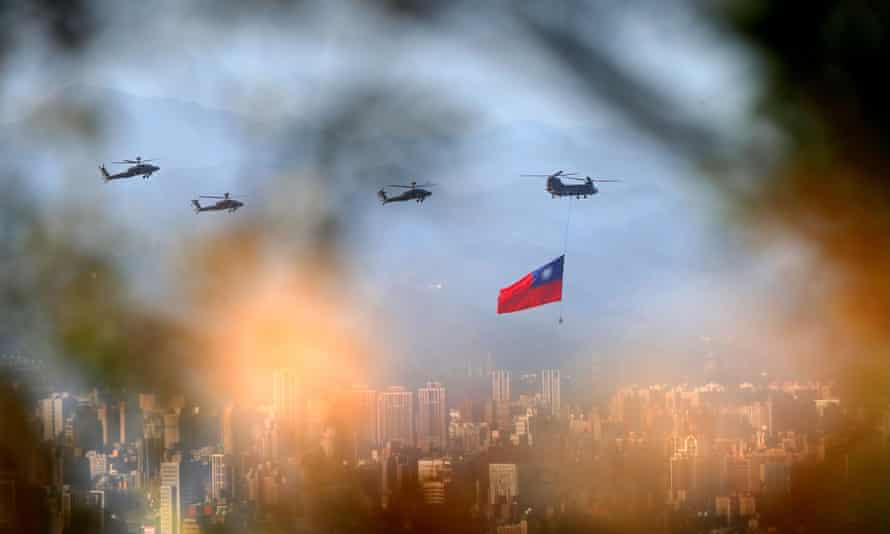Analysis: the fallout from a conflict triggered by miscalculation or accident could be catastrophic

A surge of Chinese aerial sorties over the sea separating mainland China and Taiwan has served as a reminder that the strait has the potential to be one of the most dangerous places on Earth.
According to Taiwan’s defence ministry, the People’s Liberation Army (PLA) made a total of 149 sorties in four days over the southern section of the Taiwan Strait, including flights by a dozen bombers and many jet fighters.
The planes did not enter Taiwanese airspace, but they did fly inside Taiwan’s air-defence zone, the area monitored for approaching threats.
“It’s absolutely unprecedented in the modern history of these flights that China has run into Taiwan’s Air Defence Identification Zone,” said Taylor Fravel, the director of the security studies programme at the Massachusetts Institute of Technology. “Each day breaks the preceding record for the total number of flights on a single day.”
The surge came at the end of a set of PLA military exercises, starting on China’s national day and designed to send a message that Beijing would continue to step up pressure on Taiwan to submit to eventual unification – responding by force if Taiwan’s leadership tried to make moves towards formal sovereignty.
“The Chinese are using these flights increasingly for training purposes and this is actually the end of the typical annual training cycle,” said Bonnie Glaser, the director of the Asia programme at the German Marshall Fund.
“The other purposes they serve is to signal to the United States and Taiwan not to cross Chinese red lines. And to stress Taiwan’s air force, to force them to scramble, to stress the aircraft, the pilots, force them to do more maintenance and test the responses of Taiwan’s air defence system.”
As Joe Biden pivots US foreign policy towards a focus on the Indo-Pacific as the main arena for 21st-century superpower competition, bolstering allies and seeking to contain Chinese expansionism, his administration has sought to maintain same balance attempted by previous presidents over the decades since the adoption of the “One China” policy, recognising the People Republic of China as the sole sovereign Chinese state, while propping up Taiwan’s ability to defend itself.
The US has attempted to deter China from an outright invasion by maintaining ambiguity over whether it would come to Taiwan’s defence, while seeking to deter Taiwan from declaring outright independence, which would be a red line for Beijing.
This balancing act on Taiwan has been played out in part through diplomatic nuance. There is some question whether the Biden administration would allow the Taipei Economic and Cultural Representative Office to rename itself the Taiwan Representative Office, upgrading its status. That decision has so far been deferred.
Meanwhile, Taiwan’s defence minister has chosen not to attend a conference in Maryland this month, sending his deputy instead, a move aimed at avoiding further irritation for China after Taiwan had applied to join a trans-Pacific trade partnership less than a week after Beijing had done the same thing.
The manoeuvring in the South and East China Seas is blunter than the diplomatic choreography, involving large amounts of lethal military hardware. As China ratchets up its war games, the US is building its own military presence and firming up alliances, most notably with the surprise announcement of the Aukus partnership with Australia and the UK last month.
France is also seeking to make its presence felt in the Pacific, while Japan is moving towards a more assertive use of its substantial navy, adding to the maritime jostling.
The US relationship with Taiwan falls well short of a security pact, but Fravel said that in the event of a Chinese attack there was a general expectation in the region that the US would come to the island’s defence.
“I think if there was sort of a bolt from the blue by mainland China against Taiwan, unprovoked, it’s hard to believe that the United States wouldn’t come to Taiwan’s aid,” he said. “In what form, it’s hard to predict this, because it would depend on the intensity of the attack and so forth.”
He added that US military intervention was not inevitable if the origins of a conflict across the strait were less clearcut – a messy accident or a provocative Taiwanese move, for example.
“If we were back where we were with Taiwan 10 or 15 years ago with a very sort of active independence-oriented president and that precipitated a conflict across the strait, I’m not sure the United States would necessarily come to Taiwan’s aid in the first instance,” Fravel said. “It would depend on how it played out. But the fundamental US goal is to maintain stability across the strait and to prevent a conflict from occurring.”
With the steady buildup of troops and equipment and the proliferation of war games, there is also more of a chance of conflict triggered by miscalculation or accident.
In 2001, there was a collision between a Chinese fighter jet and a US reconnaissance plane, largely as a result of reckless behaviour of a particularly aggressive Chinese pilot.
“On both sides, these pilots are very well trained … so I don’t think the risk is high but it is certainly not nonexistent,” Glaser said. “But if you get a real aggressive pilot, like in 2001, you can certainly have an accident, or if a fighter pilot momentarily loses his bearing and doesn’t know where he is in the sky, that could be catastrophic.”
